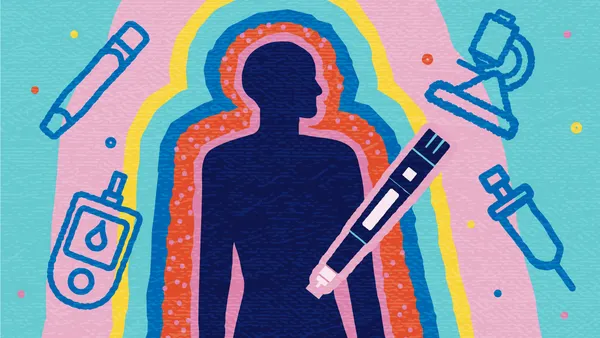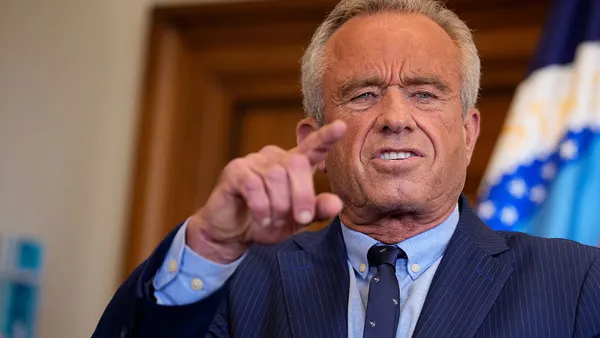The pharma industry’s most valuable companies have spent the last few years playing musical chairs as they balance major wins of newer drugs with the decline of those reaching the end of their lifecycle.
Johnson & Johnson, long a mainstay at the very top of Big Pharma’s market cap list, now sits at third as sales of its immunology megablockbuster Stelara stagger in the face of incoming competition — still, the company has a rich bullpen to fall back on. Similarly, AbbVie’s powerhouse Humira is dealing with stiff biosimilar competition, but the company ranks fourth as it fills that gap with newer products. Pfizer, on the other hand, whose COVID-19 vaccine Comirnaty was the bestselling pharmaceutical product of all time during the pandemic, faded just as quickly to the bottom of the top 10.
Now, diabetes and obesity drugmakers Eli Lilly and Novo Nordisk cast a long shadow among the top pharmas. Novo’s GLP-1 Ozempic in particular drove the Danish company to second place, and Lilly has GLP-1s Mounjaro and Zepbound — as well as a diversified lineup behind them — to thank for landing at the top of the list.
With all 10 companies reporting earnings for the first half of the year, here’s a look at the bestselling drug from each of the pharma giants, with some insight into how they got there and how they fit into each company’s overall portfolio and strategy.
Eli Lilly, now the largest pharma company by market cap and among the largest companies of any kind in the world, can credit the diabetes and weight loss drug Mounjaro for much of its recent success. Revenue for the drug tripled year to year, garnering revenue of $4.9 billion in the first half of 2024 compared to $1.5 billion the year before. In the second quarter alone, the drug made more than $3 billion for the Indianapolis drugmaker. With sales of its older diabetes blockbuster Trulicity falling by almost a third, Lilly needed the boost from Mounjaro, as well its other GLP-1 Zepbound and the cancer drug Verzenio.
Ozempic, once the little engine that could, is now a sales freight train barrelling through the pharma ranks with a trajectory to become one of the bestselling drugs of all time. With the equivalent of $8.3 billion in sales in the first half, Novo’s share prices have skyrocketed as Ozempic grows, so far limited only by the rate of production. While the Danish company’s shares faltered due to missed second-quarter earnings for its other GLP-1 Wegovy, the tremendous growth of these diabetes and weight loss treatments has inspired other pharma giants — including Pfizer, Roche and Amgen — to step into the weight loss arena. Nevertheless, Novo could be vulnerable as it’s highly dependent on Ozempic’s further success with 43% of overall sales coming from the one drug.
J&J’s immunology treatment Stelara, which brought in almost $11 billion in 2023, is on a slippery slope as biosimilar copycats begin entering the market this year. The company’s portfolio, however, runs deep, with multiple myeloma blockbuster Darzalex on track to rake in about as much this year, drawing $5.6 billion in the first half. In fact, oncology is shaping up to be J&J’s post-Stelara core focus with cell therapy Carvykti and multiple myeloma drug Tecvayli growing in profile. The company has also used its deep pockets to fill the R&D coffers through acquisitions that provide a long runway into the future. For now, Darzalex is just the first of a handful of products lined up to defend Stelara’s legacy.
Humira, just a few years ago the bestselling drug in the world, has fallen to the middle of the pack as biosimilars take huge chunks out of sales. But AbbVie has been ready for this moment, and fellow immunology treatment Skyrizi is almost ready to eclipse Humira in sales. Compared to Humira’s $5.1 billion in the first half of the year, a decline of more than 32% from the same period in 2023, Skyrizi sales grew 46% to $4.7 billion, demonstrating that AbbVie is likely picking up many of the same patients rather than watching them swing over to the competition.
Over the course of a decade, Merck’s oncology powerhouse Keytruda has been approved for dozens of cancer types and still holds the largest clinical research program in the space with more than 1,600 ongoing trials, according to the company. With more than $14 billion in first-half sales this year, Keytruda shows no near-term signs of slowing. However, with future biosimilars on the horizon in 2028, Merck’s dependence on the drug that makes up half of its overall sales is a warning sign. But there’s still time, and 2028 sales estimates call for more than $33 billion just before the competition comes into play. Merck’s next top seller is the HPV vaccine Gardasil, which brought in $4.7 billion in the first half, a third of Keytruda’s payday.
Ocrevus remains the top-prescribed multiple sclerosis drug in the U.S., and steady sales have kept Roche in the ranks of the biggest pharmas in the world, along with a slate of blockbuster products from oncology to immunology. And in the works for the Swiss drugmaker is a new formulation of Ocrevus with an easier injection regimen and the same efficacy as the hospital-infused type sold today — the subcutaneous injectable version is testing well in late-stage studies and is in regulators’ hands in the U.S. and Europe.
AstraZeneca CEO Pascal Soriot has promised investors an ambitious $80 billion in annual sales by 2030 — at almost $26 billion halfway through this year, he has some ground to make up by the end of the decade. Still the rate of growth is impressive, with 18% revenue improvement over the previous year’s first half. The diabetes and heart failure drug Farxiga led the way with $3.8 billion in revenue, followed closely by the cancer drug Tagrisso and a lineup of other oncology treatments like Imfinzi, Calquence and Lynparza.
Novartis has a deep bench of blockbusters lined up in 2024. Halfway through the year, 14 of the Swiss pharma giant’s drugs pulled in more than $500 million, with the cardiovascular treatment Entresto leading the way at nearly $3.8 billion in net sales. But Entresto faces a slew of trouble — Novartis has fought to keep generics from hitting shelves, and the drug is among the 10 selected as part of the Inflation Reduction Act’s Medicare negotiation program. Not far behind Entresto, though, was the immunology drug Cosentyx with $2.9 billion and the multiple sclerosis drug Kesimpta growing 66% to $1.4 billion in sales. Kesimpta’s self-administered dosing beat Roche’s Ocrevus to the punch and is shaping up to be a major competitor in that space.
Amgen may not have the biggest sellers, but with the bone health drug Prolia coming in at $2.2 billion halfway through the year and 12 more products netting more than $500 million each in that time, its bench of blockbusters runs deep enough to keep the company in the top 10. Amgen is also an R&D powerhouse and last year closed a $27.8 billion deal to buy rare disease drugmaker Horizon Therapeutics, bringing in the newcomer Tepezza that has already collected $903 million in the first half.
Just a few years ago, Pfizer was riding high on the success of Comirnaty, the first mRNA vaccine approved to prevent COVID-19. But as the pandemic faded into memory, so did Pfizer’s journey to the top. Now barely among the 10 most valuable pharma companies, Pfizer depends on the cardiovascular drug Eliquis, which is shared with fellow beleaguered drugmaker Bristol Myers Squibb. At $3.9 billion in revenue halfway through the year, Eliquis is still a major player, but like Novartis’ Entresto, it’s among the list of drugs to be negotiated by Medicare as part of the IRA. Pfizer has a few more tricks up its sleeve, though, in the pneumococcal vaccine Prevnar that pulled in more than $3 billion and the COVID-19 pill Paxlovid that still made $2.3 billion despite a 46% drop from the year before. Pfizer’s $43 billion buyout of cancer drugmaker Seagen is also likely to pay off in years to come.













